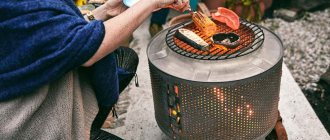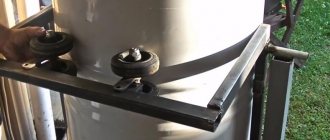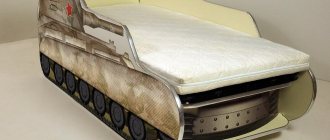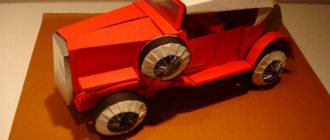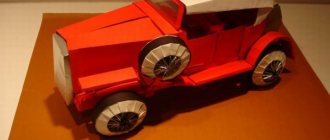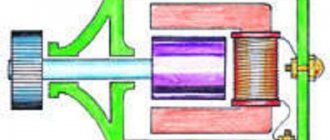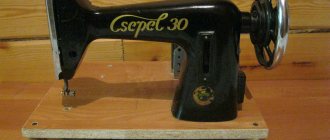Everyone who breeds birds at home has more than once encountered such a process as processing carcasses. In this case, the carcass is doused with boiling water and the feathers are removed manually. It is acceptable for small quantity.
But if you are selling a large volume of products, then manual labor is long, tedious and ineffective. It is not necessary to buy special equipment; you can make your own feather removal machine from a washing machine.
How a homemade feather removal machine works
Before getting acquainted with the types of plucking machines, let's consider the principle of operation of the equipment. The machine consists of a container, on the sides of which there are rubber beaters. They have a ribbed surface, which allows you to grab and pull out feathers, while the bottom of the container rotates. As you can see, a feather removal machine is a simple device.
How to use the pinching technique:
- A scalded bird carcass is lowered into the machine.
- The equipment is connected to the network. The bottom rotates - the carcass begins to jump and hits the “rubber fingers”. Feathers fly off.
At the end you will get an almost completely plucked bird, only small feathers on the legs will remain.
Which bird is used to pluck a feather plucker?
Types of bird pickers
Based on the mechanism used, the designs are divided into:
- Centrifuge . The container is generally round in shape and has a vertical opening into which the bird is loaded. Beaters on the bottom and sides of the container help pluck feathers as the bottom rotates. During operation, water is supplied to the tank for greater plucking productivity. Suitable for small birds: quails, chickens, ducks.
- Drum type . The “tentacles” are located on the surface of the drum, which is rotated by a motor. You need to bring the carcass to the drum and press it. This way you can pluck a large bird, but for small ones it is not very convenient.
- Power tool with attachment . Making such a plucking machine would be very cheap. An attachment with “tentacles” is put on the instrument and brought into the carcass. It is not very convenient to use - your hands will get tired. Therefore, to process large quantities of poultry, use the previous options.
In one hour of working with a poultry picker, you can process up to 30 carcasses.
We suggest making a homemade feather plucker from a washing machine.
Bowstring
If the bowstring is of high quality and you take good care of it, you will use it for a long time. As a rule, steel is used for the bowstring (strings or cables) or weaved from silk. True, nowadays there are a huge number of synthetic materials. If you make a bowstring from Kevlar, it is used as a material with high tensile strength (specific resistance).
In powerful crossbows they use a thin steel cable, which serves as a bowstring. You can find this in both cars and motorcycles. Breaking loads are most easily borne by a braided bowstring. This happens due to the fact that a particle of energy goes into friction between synthetic threads. In order to protect the bowstring from abrasion on the stock, use special linings made of plastic or metal.
Instructions: how to make a feather removal machine from an automatic and semi-automatic machine
Before you make a chicken plucker yourself, prepare a drawing. It will help you take into account and calculate all structural elements, as well as correctly assemble the mechanism.
For production, you can take an automatic or semi-automatic washing machine. The main thing is that the washing machine is working and top-loading. It could be “Baby”, “Fairy” or “Oka”.
You will need to purchase rubber beaters. These are inexpensive parts, and you can buy them on the market or order them from an online store. It is worth considering that the size of the beaters depends on the dimensions of the carcass: the largest are for geese and turkeys, the smallest are for quail.
If you are worried that the carcass may be damaged during plucking, this is not the case. Rubber tentacles ensure maximum safety of the bird.
What tools will you need:
- set of wrenches;
- socket wrenches 8-30 mm;
- small adjustable wrench;
- drill with step drill;
- Bulgarian;
- pliers;
- hammer;
- tester or multimeter;
- marker.
Now prepare the washing machine. It needs minimal alteration, so no special costs are expected.
Converting a washing machine into a feather removal machine
All you need to do is remove the motor from the housing. Since holes for the beaters will be made in the bottom of the housing, the flowing water will fall on the engine during operation. This cannot be allowed.
Disconnect the bottom and remove the electric motor. Then do this:
- Remove the activator with the drive mechanism.
- Remove all electrical parts.
- After preparing the washer, take the shower head and attach the rubber hose to it.
You won't need a shower or hose now, but you should prepare them in advance.
Assembling the perso-removable structure with your own hands
Now you need to assemble all the elements into a single device. Do this:
- Weld a motor support from a steel corner.
- Connect the electric motor to the network. We talked about how to do this correctly in previous articles.
- Build a frame for the finished device from a metal corner. The body must be at some height from the ground.
- To make the structure work, install pulleys. You can take them from the same washing machine.
- Place the small pulley on the motor shaft, and the large pulley on the activator shaft.
- Connect the pulleys with a belt. This will allow the motor to transmit speed to the activator, which will rotate the bottom of the device.
- Now make sure that the housing and motor are securely installed, as strong vibration may cause them to fly off.
Read also: Welding in carbon dioxide with a consumable electrode
All that remains is to install the rubber beaters. Proceed sequentially:
- Make holes in the tank using a drill with a step bit. Depending on the size of the beaters, the size of the holes should be three or four millimeters smaller.
- To allow waste water and feathers to escape, make larger holes between the main holes. Then install a tray or wide container under the tank to collect waste.
- To facilitate installation of the beaters, the holes are lubricated. You can use machine oil. After lubrication, insert the rubber beaters into the prepared holes.
To protect the motor from water, make a plastic casing for it from a can or box.
Assembly of the feather removal machine is complete. To ensure that water flows during operation, install the previously prepared hose and shower head on the edge of the container.
Test work
Time to check out your homemade device.
Why is it recommended to use watering when plucking? Because within 2 minutes of the bird beating against the beaters with the flow of water, all the feathers fly off. While with the dry version, large feathers remain on the bird and more time is spent.
Since a lot of water leaks out during operation and feathers fly, carry out the procedure in a specially designated area.
The feather removal machine is an example of elementary automation of farm labor. Those who breed poultry know how labor-intensive the process of plucking—removing feathers from bird carcasses—is. Even with a small population, plucking takes a lot of time and effort, let alone a farm raising chickens, ducks, turkeys and other poultry for sale. Owners of small poultry farms replace manual labor with special devices. You can buy a feather plucker or make it yourself - for example, from a washing machine.
Necessary materials and tools for making flies
To learn how to make flies with your own hands, you should stock up on certain materials and tools. Tying flies is not very difficult and can be done by any amateur fisherman. As a rule, the fisherman already has most of the necessary tools, because it is impossible without them.
To tie flies you will need the following tools:
- vice;
- needles;
- knotweed;
- overexposure;
- scissors;
- threader;
- bobbin thread holder;
- tweezers;
- magnifying glass;
- mirror;
- lamp;
- mortar;
- brush.
To do this you will need the following materials:
- Hooks. For tying flies, you should purchase special hooks, but you can also use regular ones: for dry flies, use hooks made of thin wire, and for other types of flies, thicker ones.
- Bird feathers. As a rule, rooster feathers are used.
- Dabbing.
- Wool.
- Lurex.
How does a plucking machine work?
A homemade feather plucking machine is assembled from a reservoir and rubber parts placed on its inner surface. These parts are called hammer fingers - they are the main part of the device. It is impossible to make these ribbed elements yourself - you have to buy them.
One chicken picker can contain up to 120 beating fingers. Their cost is rather high - on average 20–40 rubles per piece. However, this is the only major expense that will be incurred when creating a homemade product from an old washing machine. Everything else can be found on the farm - a feather plucker assembled with your own hands will cost you little. But the result is excellent: the fuss with plucking will be replaced by an electromechanical installation.
When purchasing pickers, consider the size of the carcasses being plucked. Quail beaters are not suitable for geese, broilers and other larger animals.
Popular models
Below are the most popular models of feather removal machines made in Russia and abroad.
- The Italian Piro model is designed for plucking medium-sized carcasses. Can process up to three pieces at the same time. The productivity of the device is 140 units/h, the engine power is 0.7 kW, the power source is 220 V. The unit is produced in dimensions 63x63x91 cm, weighs 50 kg and costs about 126 thousand rubles.
- The Rotary 950 model was developed by Italian specialists based on German technologies and is produced in China. The device belongs to the category of professional equipment, so the time for complete processing of a carcass does not exceed 10 seconds. The weight of the device is 114 kg, the power of the electric motor reaches 1.5 kW, and it is powered by a voltage of 220 V. The model is equipped with 342 fingers of different hardness, is available in dimensions 95x95x54 cm and is capable of processing up to 400 carcasses per hour. The unit is additionally equipped with protection against power surges, has a European certificate and complies with all international safety standards. The cost of Rotary 950 is 273 thousand rubles.
- The Ukrainian model “Farmer's Dream 800 N” is a very reliable and durable device. The carcass plucking percentage is 98, processing time is about 40 seconds. The device is equipped with a 1.5 kW electric motor, is powered by a 220 V network and weighs 60 kg. The device meets all safety standards and can operate in both automatic and semi-automatic modes. Such a device costs 35 thousand rubles.
- The Russian Sprut machine is a professional model and is equipped with a spacious drum with a diameter of 100 cm. The engine power is 1.5 kW, the power supply voltage is 380 V, dimensions are 96x100x107 cm. The weight of the product is 71 kg, and its cost reaches 87 thousand rubles . The device is equipped with an external remote control and an irrigation system with manual start. You can load 25 chickens or 12 ducks into the drum at a time. In an hour, the device is capable of plucking up to a thousand small chickens, 210 turkeys, 180 geese and 450 ducks. The payback period for the device is 1 month.
For a review of the feather removal machine for plucking poultry, see the video below.
Plucking carcasses is a long and unpleasant process.
To mechanize the procedure in the household, a feather removal machine was created, which can be purchased at a specialized store or made with your own hands from scrap materials.
How does the plucking machine work?
- A chicken carcass, previously scalded with boiling water, is placed in the container.
- The bird picker is plugged into the mains.
- After switching on, the bottom begins to rotate. The carcass, jumping, hits the ribbed rubber fingers. Feathers fly off her.
- The result is an almost perfectly plucked chicken, duck, goose, and so on. All that remains is to remove the small feathers on the paws.
The poultry plucker can handle almost any poultry - you can use it to pluck chickens, ducks, geese, quails, and turkeys.
What is the design?
- Centrifuge. A round container with a hole for loading carcasses is used. Beaters located on the bottom and sides of the barrel remove feathers as the bottom rotates. As work progresses, water enters the container to enhance the productivity of the process. This design is suitable for small animals - no larger than a duck.
- Drum. A drum with “tentacles” is used - it is rotated by a motor. The carcass is simply brought to the rotating drum and pressed. This option is convenient for large birds.
- Electric tool. This machine with an attachment requires virtually no investment. An attachment with “tentacles” is put on the rotating instrument. He is brought to the scalded carcass. The disadvantage of this option is that your hands get tired quickly.
When using the first option - a centrifuge, you can pluck 30 chickens.
What to make a feather plucker from?
Before assembling the device, draw up its drawings - they will help you take into account and calculate all the nuances of the design. What washing machines might be useful? Any automatic or semi-automatic washing machine that meets the following conditions:
- it must be working;
- with vertical loading.
Read also: What is the diameter of a 6 mm2 wire?
Washing machines such as “Oka”, “Fairy”, “Malyutka” are suitable as “raw materials” for bird pluckers. Don’t worry - the carcass in the plucker will not be damaged and will not lose its presentation: the rubber fingers are soft enough and will not cause harm.
How to make a feather plucker from an automatic washing machine?
Assembling the feather removal machine consists of several stages. First, remove the motor from the washing machine body. It is important to take into account this point: when the device is operating, water will be supplied to the tank. Since you will have to make holes in the bottom for the beaters, the water flowing down will fall on the engine. This must be prevented. Perform the following actions:
- Remove the bottom and remove the engine.
- Remove the activator with the drive.
- They take out all the electrical “stuffing”.
- Place a rubber hose on the shower head - you will need it later.
Let us next consider the assembly procedure step by step.
Setting the operating mode
The drum in the bird picker should rotate in one direction. If in the washing machine it rotates alternately in different directions, you should reconfigure its operation to the correct mode. How to do it? Disconnect the body and bottom and connect the wires in the correct order. The ends of the wires are connected to the power cord. The washing machine has a hose. It is not needed in the bird picker, so it is cut off. The hole is sealed with sealant.
Creating holes
When the hose is removed and the wires are rearranged, they begin to connect the bottom of the structure to the body. Remove the screw and plug from the drum. Then, having dismantled it, they begin to create a device equipped with “fingers” - you need to attach ribbed elements. Procedure:
- The holes are drilled with a drill. You will need a special drill - a stepped type. The dimensions of the holes depend on the beaters - they are made 3–4 mm smaller to strengthen the fastening.
- When the plucker rotates, feathers and water should come out of it. To do this, additional holes are made between the holes for the beats - larger ones. Some kind of vessel is placed below to receive waste.
- To facilitate the installation of rubber “tentacles”, the holes under them are smeared with machine oil.
- To protect the engine from liquid ingress, a special protective housing is made. It is made from a plastic container.
Assembly
- A steel corner is used to create a support for the motor.
- Connect the engine to 220 V.
- A metal frame is welded from the corner - the body of the device should be at a distance from the ground.
- The pulleys are installed - they are also taken from the washing machine. The small one will be placed on the motor shaft, the large one on the activator shaft.
- The pulleys are connected by means of a belt so that the engine transmits movement to the activator and the bottom of the chicken picker rotates.
- Check the strength of the fastening of the housing and the motor - they will experience strong vibrations and, if the fastening is unreliable, they may simply fly off.
This completes the assembly. All that remains is to install a hose with a shower nozzle, prepared in advance, on the edge of the tank to water the carcasses with water.
Tests
All that remains is to check the homemade device. Turn on the machine and throw the chicken or duck into the drum. Don't forget to provide water supply. When plucking dry, much more time is spent than with water. When the carcasses are sprinkled with “rain,” the feather flies off them in two minutes. The dry version also leaves a large feather. Please note that during plucking, a lot of water flows out, and feathers can fly to the sides, so you should also choose a special place for the feather plucker.
The described device allows not only to simplify the process of plucking poultry, but also to save on the purchase of an expensive industrially produced plucker. An old washing machine, a set of tools and minimal technical skills will help you become the owner of another useful household device.
Simple manual labor can be easily replaced with automated one. Thus, plucking geese can be entrusted to a special device - a plucking machine. You can either purchase it or make it yourself.
It is difficult to deny the value of goose meat and feathers. Many people can handle cutting meat, but not everyone knows how to properly pluck a bird so as not to spoil the feathers themselves and not leave stumps on the carcass, which will reduce its value.
On a large farm there is no time for such a long procedure as plucking. However, it is quite difficult, so it is better to use a plucking device. The process of its creation lasted a relatively long time.
Read also: Polymers used in everyday life
In the middle, friction is provoked, which causes the fingers to cut into the carcass and tear out feathers. The drum is mounted on a moving axis.
The goose feather removal machine not only saves time, but also improves labor productivity. If you have a small number of poultry, then there is no point in buying an expensive machine; it is better to make it yourself. The devices differ:
- Dimensions;
- Power;
- Number of fingers.
A homemade geese machine consists of:
Working with a goose tweezer consists of the following steps:
- After slaughtering poultry, leave the carcass for a couple of hours;
- After this, dip it in warm water for 2-3 minutes;
- Comb all feathers thoroughly. Immerse in boiling water for 2 minutes. The main thing is not to keep it for too long;
- Place the carcass in a preheated machine;
- During the automated plucking process, pour boiling water over the goose. Take it out and rinse with cool water;
- Clean areas where feather cover has not been completely removed.
If the fluff is small and soft, burn it, and then use a sharp blade to remove the spoiled areas and rinse the goose under running warm water.
It is used together with a sharpening machine or a screwdriver. The main component of the nozzle is the drum, which must have sufficient rigidity to work effectively.
Instructions for making a plucking attachment:
- Attach the bottom to a pipe with dense metal walls using screws;
- Make a hole in the center of the bottom. Insert a pin into it and secure it with two screws. Choose a diameter so that the pin is securely held in the tool used for work;
- Drill several holes around the circumference of the drum; Make them in several tiers, placing them at equal distances;
- Insert strong pen removal pins into the holes.
A machine of this type, despite its apparent primitiveness, will allow you to pluck not only geese, but also chickens, quails, ducks and turkeys. It will be useful not only for the farmer, but also for the hunter interested in processing carcasses.
The device can be constructed from a part of a pipe with a diameter of 100 mm. For this option you will need two bottoms, which can be made of wood or plastic. In the center of the bottoms you need to drill a hole through which to insert a pin to tie the mechanism and use it on the tool. As with the previous nozzle, you need to make holes in a circle and tuck your fingers into them.
- Frame on which the drum is mounted;
- Electric motor;
- Belt drive system;
- Feather container;
- Drum of any length with 2 axes.
The creation technology is similar to those presented above.
You can make a strong device from an activator-type washing unit, which is a container for plucking. The convenience of this design is that the lower section is initially equipped with a drive that can be used to transmit rotations. It is also convenient that the tanks are made of durable steel.
To transform an outdated washing machine into a powerful pinching unit, you need to build a rotating type bottom and connect it to the shaft. The bottom can be made from durable sheet metal.
Large intervals between structural elements should not be made, as parts of the carcasses will fall into them. Before fixing the bottom, you need to drill holes to fix the hammer fingers. They are drilled on the side surfaces.
Plucking geese in this design is carried out with water, so it is important to make holes for water to drain. Their diameter (mm) should be sufficient to allow clumps of feathers to escape. It is permissible to use a colander as a filter.
For a constant supply of water, you can connect a plastic hose to the inner surface of the drum.
The big advantage is that such a mechanism will be able to pluck not only geese, but also all poultry. A similar option can be done with a plastic barrel, but then you will need to make the frame yourself and build the drive mechanism.
Creating such a product with your own hands is a simple process that anyone can easily master. The main thing in this matter is to understand the importance of each component element and not neglect it. The correct sequence of actions and the use of durable materials are the key to ensuring that the structure will last a very long time.
DIY pike streamer
In the summer, aquatic vegetation grows rapidly, so many reservoirs become overgrown, making it impossible to use conventional baits. In this case, non-hooking baits are better suited, which increase the chances of catching fish, since most species of fish prefer to be in thickets of aquatic plants. Some hide in the thickets from predators, while others ambush representatives of peaceful fish. Many anglers use a pike streamer, both with a regular hook and with a non-snag hook. Such baits can be used in tackle with a Sbirullino float or in regular tackle. To facilitate the casting process, it is worth securing the appropriate weight on a separate leash.
The basis of any fly is a hook, somewhere around size 9 or 10. It is possible to use a special hook that has protection against snagging . In addition to the hook, you will need wool and a piece of lurex.
First, a piece of lurex, about 5 cm long, is wound to the shank of the hook. After this, the lurex must be fluffed using a needle or other sharp but thin object. Using the same thread, a rooster feather is attached on top of the lurex. You can use wool of different colors, but no more than five, since the presence of a large number of shades on the bait can scare away the fish. After this, the thread should be secured with nail polish. After fixing the product, the hairs are fluffed out using an awl or needle. The bait is ready for use.
This streamer catches perch perfectly if you additionally attach a certain weight to it. This bait will please the amateur fisherman with its effectiveness when catching pike or perch in the middle of autumn.
